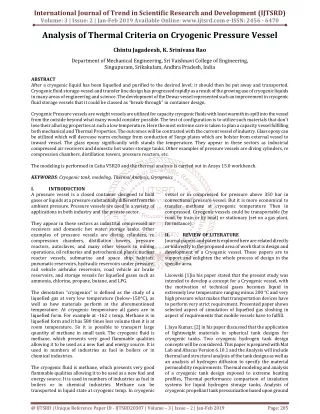Analysis of Thermal Criteria on Cryogenic Pressure Vessel
After a cryogenic liquid has been liquefied and purified to the desired level it should then be put away and transported. Cryogenic fluid storage vessel and transfer line design has progressed rapidly as a result of the growing use of cryogenic liquids in many areas of engineering and science. The development of the Dewar vessel represented such an improvement in cryogenic fluid storage vessels that it could be classed as "break through in container design. Cryogenic Pressure vessels are weight vessels are utilized for capacity cryogenic fluids with least warmth in spill into the vessel from the outside beyond what many would consider possible. The test of configuration is to utilize such materials that dont lose their alluring properties at such a low temperature. Here the most extreme care is taken to plan a capacity vessel fulfilling both mechanical and Thermal Properties. The outcomes will be contrasted with the current vessel of industry. Glass epoxy can be utilized which will decrease warm exchange from conduction of Surge plates which are bolster from external vessel to inward vessel. The glass epoxy significantly with stands the temperature. They appear in these sectors as industrial compressed air receivers and domestic hot water storage tanks. Other examples of pressure vessels are diving cylinders, re compression chambers, distillation towers, pressure reactors, etc. Chintu Jagadeesh | K. Srinivasa Rao "Analysis of Thermal Criteria on Cryogenic Pressure Vessel" Published in International Journal of Trend in Scientific Research and Development (ijtsrd), ISSN: 2456-6470, Volume-3 | Issue-2 , February 2019, URL: https://www.ijtsrd.com/papers/ijtsrd20307.pdf Paper URL: https://www.ijtsrd.com/engineering/mechanical-engineering/20307/analysis-of-thermal-criteria-on-cryogenic-pressure-vessel/chintu-jagadeesh
★
★
★
★
★
56 views • 4 slides
